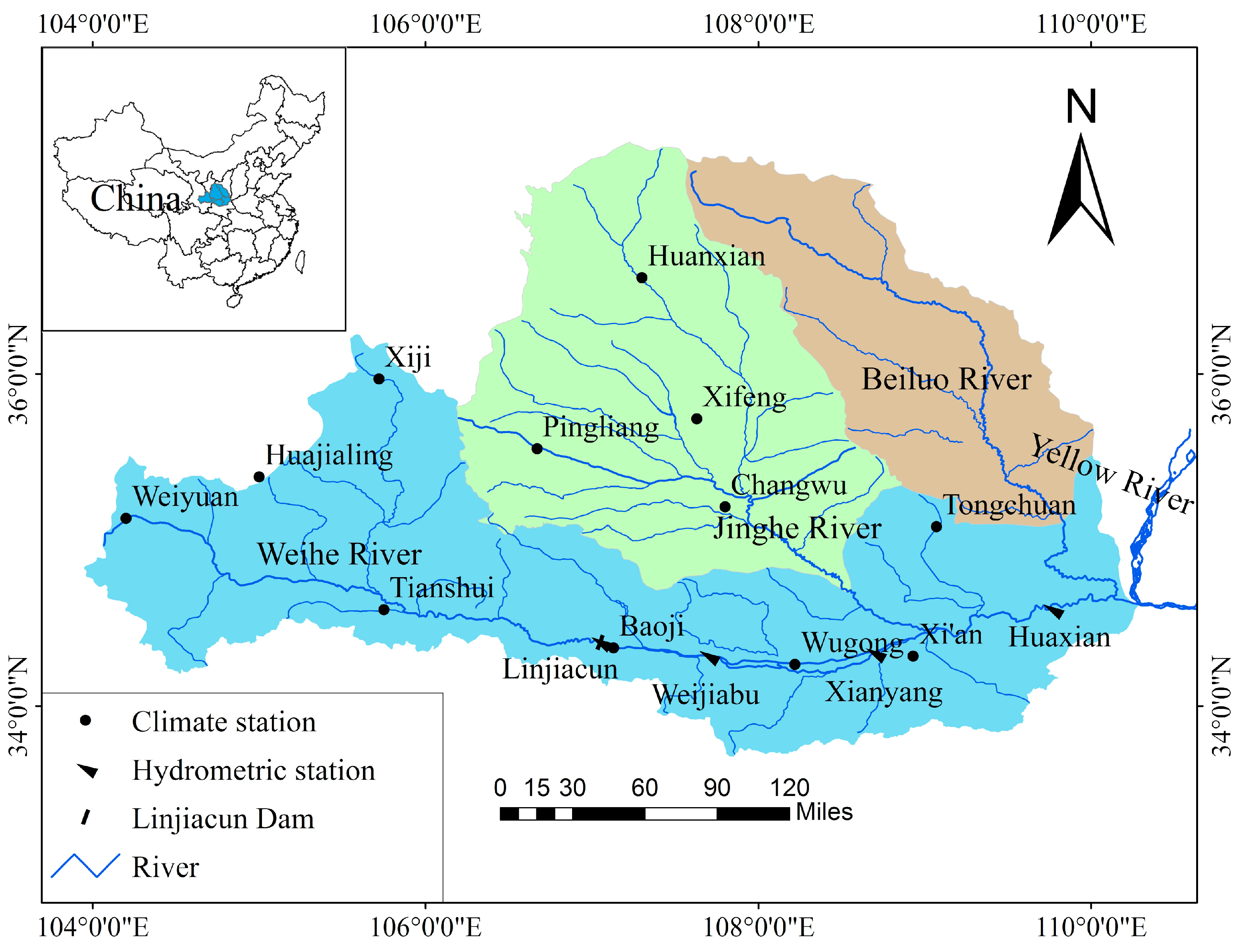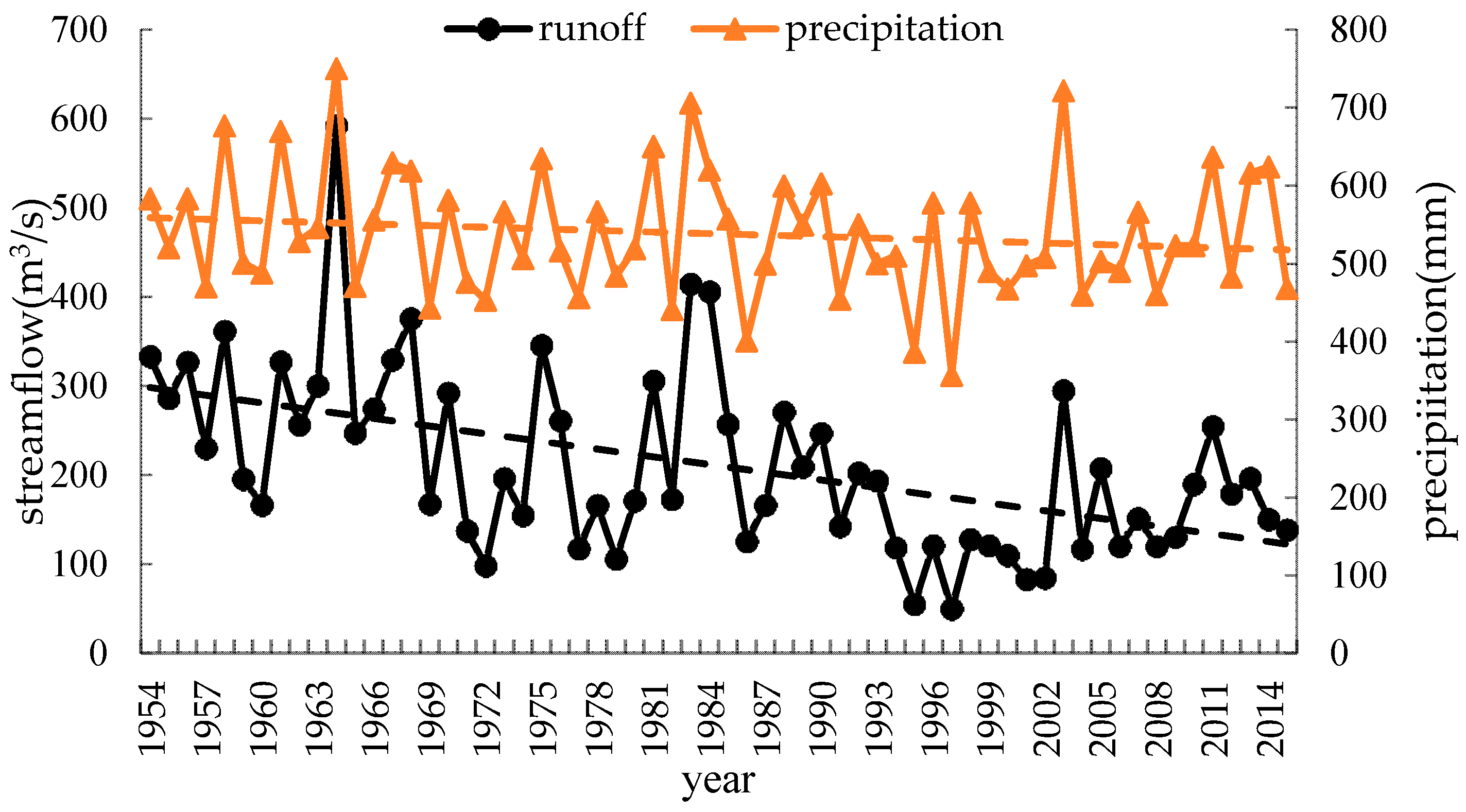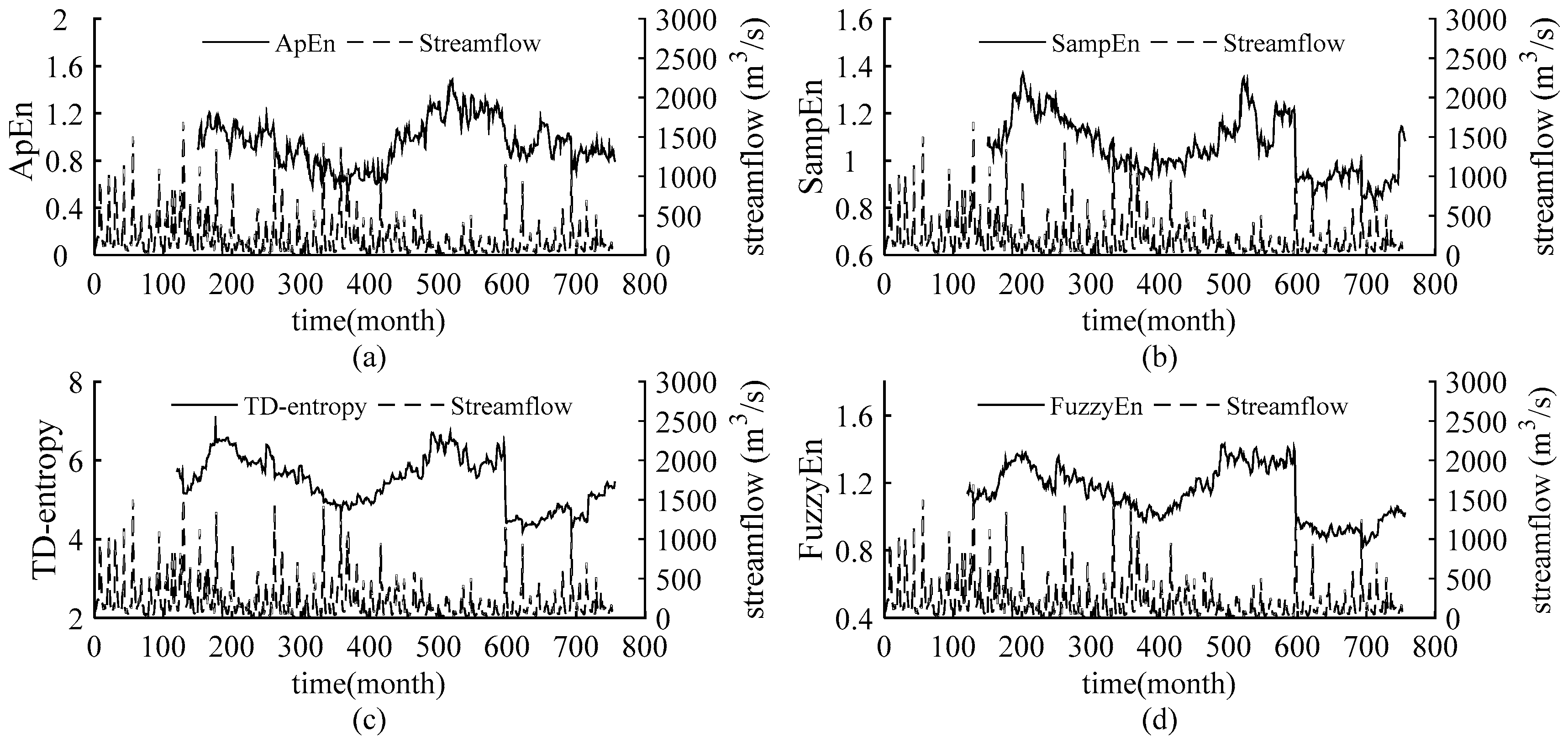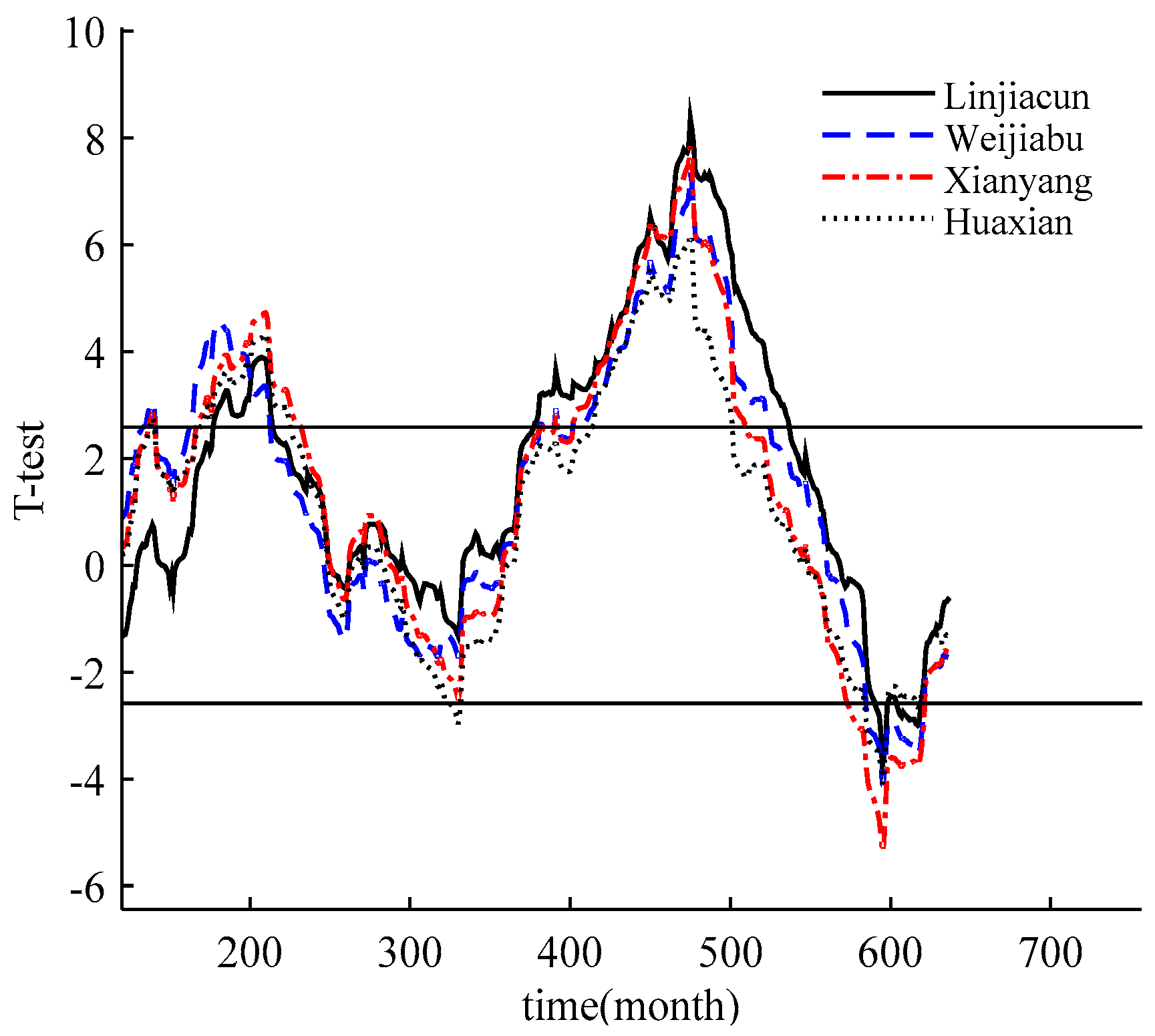Analysis of Streamflow Complexity Based on Entropies in the Weihe River Basin, China
Abstract
1. Introduction
2. Methods
2.1. Approximate Entropy
2.2. Sample Entropy
2.3. Two-Dimensional Entropy
2.4. Fuzzy Entropy
2.5. Sliding t-Test
2.6. Brown–Forsythe Test
2.7. Cumulative Anomaly
3. Application
3.1. Gauging Location
3.2. Data Used
3.3. Parameter Selection
3.4. Spatial Difference for Streamflow Complexity
3.5. Dynamic Change for Streamflow Complexity
3.6. Comparative Analysis of Streamflow Variability
4. Conclusions
- ApEn, SampEn, TD-entropy and FuzzyEn are effective in the quantitative analysis of the complexity of hydrologic systems and can effectively characterize the variation in streamflow complexity. It has been confirmed that ApEn and SampEn detected streamflow complexity in this paper. In addition, the satisfactory results lead us to conclude that TD-entropy and FuzzyEn have better continuity and relative consistency and that TD-entropy has a larger range of entropy values. These two entropies are more suitable for short and noisy hydrologic time series, more effectively identifying the streamflow complexity.
- The streamflow complexity undergoes spatial difference across the Weihe River basin. The complexity of the streamflow increases gradually along the Weihe River, except for the Linjiacun station, whose complexity increases due to the reservoir operation.
- The dynamic changes in the complexity of the streamflow series have been surveyed for four gauging stations, employing the four sliding entropies. It was found that there is a relation of peak-to-valley correspondence between the runoff process and the entropy values for each station, and, the observed streamflow series at the Weijiabu station changed in 1968, 1993 and 2003 and changed in 1971, 1993 and 2003 at the Linjiacun station, Xianyang station and Huaxian station. The sliding t-test and Brown–Forsythe test confirmed the results of the entropies.
- This paper introduces TD-entropy and FuzzyEn into the hydrologic system and expects to provide more effective methods for analysing the complexity of hydrologic systems. The results could be very useful in identifying variation points of streamflow series, a key in modelling and prediction.
Author Contributions
Funding
Acknowledgments
Conflicts of Interest
References
- Mihailović, D.T.; Nikolić-Ðorić, E.; Arsenić, I.; Malinović-Milićević, S.; Singh, V.P.; Stošić, T.; Stošić, B. Analysis of daily streamflow complexity by Kolmogorov measures and Lyapunov exponent. Physica A 2019, 525, 290–303. [Google Scholar] [CrossRef]
- Feng, G.Z.; Song, S.B.; Li, P.C. A statistical measure of complexity in hydrological systems. J. Hydraul. Eng. 1998, 29, 76–81. [Google Scholar]
- Rui, X.F.; Liu, N.N.; Li, Q.L.; Liang, X. Present and future of hydrology. Water Sci. Eng. 2013, 6, 241–249. [Google Scholar]
- Singh, V.P. Handbook of Applied Hydrology, 2nd ed.; McGraw-Hill Education: New York, NY, USA, 2011. [Google Scholar]
- Haddeland, I.; Heinke, J.; Biemans, H.; Eisner, S.; Flörke, M.; Hanasaki, N.; Konzmann, M. Global water resources affected by human interventions and climate change. Proc. Natl. Acad. Sci. USA 2014, 111, 3251–3256. [Google Scholar] [CrossRef]
- Kolmogorov, A.N. Three approaches to the quantitative definition of information. Int. J. Comput. Math. 1968, 2, 157–168. [Google Scholar] [CrossRef]
- Mihailović, D.T.; Nikolić-Ðorić, E.; Drešković, N.; Mimićd, G. Complexity analysis of the turbulent environmental fluid flow time series. Physica A 2014, 395, 96–104. [Google Scholar] [CrossRef]
- Wolf, A.; Swift, J.B.; Swinney, H.L. Determining Lyapunov exponents from a time series. Physica D 1985, 16, 285–317. [Google Scholar] [CrossRef]
- Packard, N.H.; Crutchfield, J.P.; Farmer, J.D. Geometry from a time series. Phys. Rev. Lett. 1980, 45, 712–716. [Google Scholar] [CrossRef]
- Shannon, C.E. A Mathematical Theory of Communication. Bell Labs Tech. J. 1948, 27, 379–423. [Google Scholar] [CrossRef]
- Kang, Y.; Cai, H.J.; Song, S.B. A measure of hydrological system complexity based on sample entropy. In 2011 International Symposium on Water Resource and Environmental Protection; IEEE: Xi’an, China, 20 May 2011; pp. 470–473. [Google Scholar]
- Alfonso, D.B.; Alexander, M. Approximate Entropy and Sample Entropy: A Comprehensive Tutorial. Entropy 2019, 21, 541. [Google Scholar]
- Verde, L.; De Pietro, G. A neural network approach to classify carotid disorders from Heart Rate Variability analysis. Comput. Biol. Med. 2019, 109, 226–234. [Google Scholar] [CrossRef]
- Zheng, J.D.; Cheng, J.S.; Yang, Y.; Luo, S.R. A rolling bearing fault diagnosis method based on multi-scale fuzzy entropy and variable predictive model-based class discrimination. Mech. Mach. Theory 2014, 78, 187–200. [Google Scholar] [CrossRef]
- Huang, F.; Chunyu, X.Z.; Wang, Y.K.; Wu, Y. Investigation into Multi-Temporal Scale Complexity of Streamflows and Water Levels in the Poyang Lake Basin, China. Entropy 2017, 19, 67. [Google Scholar] [CrossRef]
- Xu, M.; Shang, P.J.; Zhang, S. Multiscale analysis of financial time series by Rényi distribution entropy. Physica A 2019, 04, 152–161. [Google Scholar] [CrossRef]
- Pincus, S.M. Approximate entropy as a measure of system complexity. Proc. Natl. Acad. Sci. USA 1991, 88, 2297–2301. [Google Scholar] [CrossRef]
- Pincus, S.M. Approximate entropy (ApEn) as a complexity measure. Chaos 1995, 5, 110–117. [Google Scholar] [CrossRef]
- Aktaruzzaman, M.; Sassi, R. Parametric estimation of sample entropy in heart rate variability analysis. Biomed. Signal Process. Control 2014, 14, 141–147. [Google Scholar] [CrossRef]
- Richman, J.S.; Moorman, J.R. Physiological time-series analysis using approximate entropy and sample entropy. Am. J. Physiol. Heart Circ. Physiol. 2000, 278, 2039–2049. [Google Scholar] [CrossRef]
- Cheng, Q.Q.; Yang, W.W.; Liu, K.Z.; Zhao, W.J. Increased Sample Entropy in EEGs during the Functional Rehabilitation of an Injured Brain. Entropy 2019, 21, 698. [Google Scholar] [CrossRef]
- Tang, L.; Lv, H.L.; Yang, F.M.; Yu, L.A. Complexity testing techniques for time series data: A comprehensive literature review. Chaos Solitons Fractals 2015, 81, 117–135. [Google Scholar] [CrossRef]
- Yu, W.J.; Yu, J.; Xu, L.Y. Research on Financial Time Series Complexity Based on Modified Sample Entropy. Comput. Tech. Dev. 2019, 29, 70–74. [Google Scholar]
- Chen, W.T.; Zhuang, J.; Yu, W.X.; Wang, Z.Z. Measuring complexity using FuzzyEn, ApEn, and SampEn. Med. Eng. Phys. 2009, 31, 61–68. [Google Scholar] [CrossRef]
- Zadeh, L.A. Fuzzy sets. Infor. Control. 1965, 8, 338–353. [Google Scholar] [CrossRef]
- Chen, W.T.; Wang, Z.Z.; Xie, H.; Yu, W.X. Characterization of surface EMG signal based on fuzzy entropy. IEEE Trans. Neural Syst. Rehabil. Eng. 2007, 15, 266–272. [Google Scholar] [CrossRef]
- Girault, J.M.; Anne, H.H. Centered and Averaged Fuzzy Entropy to Improve Fuzzy Entropy Precision. Entropy 2018, 20, 287. [Google Scholar] [CrossRef]
- Hu, J.; Liu, Y.; Sang, Y.F. Precipitation Complexity and its Spatial Difference in the Taihu Lake Basin, China. Entropy 2019, 21, 48. [Google Scholar] [CrossRef]
- Cheng, L.; Niu, J.; Liao, D.H. Entropy-Based Investigation on the precipitation variability over the Hexi Corridor in China. Entropy 2017, 19, 660. [Google Scholar] [CrossRef]
- Li, Y.B.; Xu, M.Q.; Wang, R.X.; Huang, W.H. A fault diagnosis scheme for rolling bearing based on local mean decomposition and improved multiscale fuzzy entropy. J. Sound Vibr. 2016, 360, 277–299. [Google Scholar] [CrossRef]
- Pare, S.; Bhandari, A.K.; Kumar, A.; Singh, G.K. A new technique for multilevel color image thresholding based on modified fuzzy entropy and Lévy flight firefly algorithm. Comput. Electr. Eng. 2018, 70, 476–495. [Google Scholar] [CrossRef]
- Zhang, L.L.; Li, H.; Liu, D.; Fu, Q. Identification and application of the most suitable entropy model for precipitation complexity measurement. Atmos. Res. 2019, 221, 88–97. [Google Scholar] [CrossRef]
- Liu, D.; Cheng, C.; Fu, Q.; Liu, C. Multifractal Detrended Fluctuation Analysis of Regional Precipitation Sequences Based on the CEEMDAN-WPT. Pure Appl. Geophys. 2018, 175, 3069–3084. [Google Scholar] [CrossRef]
- Padma Shri, T.K.; Sriraam, N. Comparison of t-test ranking with PCA and SEPCOR feature selection for wake and stage 1 sleep pattern recognition in multichannel electroencephalograms. Biomed. Signal Process. Control 2017, 31, 499–512. [Google Scholar] [CrossRef]
- Zhang, Y.C.; Zhou, C.H.; Li, B.L. Brown–Forsythe based method for detecting change points in hydrological time series. Geogr. Res. 2005, 24, 0741–0748. [Google Scholar]
- Weber, K.; Stewart, M. A critical analysis of the cumulative rainfall departure concept. Ground Water 2004, 42, 935–938. [Google Scholar]
- Zhao, A.Z.; Liu, X.F.; Zhu, X.F.; Pan, Y.Z.; Li, Y.Z. Spatiotemporal patterns of droughts based on SWAT model for the Weihe River Basin. Prog. Geogr. 2015, 34, 1156–1166. [Google Scholar]
- Lei, J.Q.; Huang, Q.; Wang, Y.M.; Liu, D.F. Variable fuzzy evaluation on comprehensive divisions of drought in the Wei River basin. J. Hydrol. Eng. 2014, 5, 0574–0585. [Google Scholar]
- Ren, L.L.; Shen, H.R.; Yuan, F.; Zhao, C.X.; Yang, X.L.; Zheng, P.L. Hydrological drought characteristics in the Weihe catchment in a changing environment. Adv. Water Sci. 2016, 27, 492–500. [Google Scholar]
- Niu, Z.R.; Zhao, W.Z.; Liu, J.Q.; Chen, X.L. Study on Change Characteristics and Tendency of Temperature, Precipitation and Runoff in Weihe River Basin in Gansu. J. China Hydrol. 2012, 32, 78–83. [Google Scholar]
- Wang, H.; Zhang, Y.; Liu, G.S.; Tang, Y.F.; Zhao, L.Q. Influence of Terrace Development on Hydrological Runoff Process in the Source Region of Wei River from 1970 to 2006. Res. Soil Water Conserv. 2009, 16, 220–226. [Google Scholar]
- Li, Y.Y.; Chang, J.X.; Wang, Y.M.; Jin, W.T. Spatiotemporal responses of runoff to land change in Wei River Basin. Trans. Chin. Soc. Agric. Eng. 2016, 32, 232–238. [Google Scholar]
- Bao, Z.X.; Zhang, J.Y.; Wang, G.Q.; Chen, Q.W. The impact of climate variability and land use/cover change on the water balance in the Middle Yellow River Basin, China. J. Hydrol. 2019, 577, 123942. [Google Scholar] [CrossRef]
- Zhang, L.Q.; Ren, L.L.; Jiang, S.H.; Liu, S.Y. Vegetation Change Characteristics in Weihe River Basin during 1982-2015 and Its Related Climatic Factors. J. China Hydrol. 2018, 38, 66–72. [Google Scholar]
- Zhao, A.Z.; Zhang, A.B.; Liu, H.X.; Liu, Y.X. Spatiotemporal Variation of Vegetation Coverage before and after Implementation of Grain Project in the Loess Plateau. J. Nat. Res. 2017, 32, 449–460. [Google Scholar]








| Station | Longitude | Latitude | Control Area (km2) | Max (m3/s) | Min (m3/s) | Mean (m3/s) | SD (m3/s) | Cv |
|---|---|---|---|---|---|---|---|---|
| Linjiacun | 107°03′ E | 34°23′ N | 30,661 | 470 | 0.4 | 62.17 | 6.91 | 0.95 |
| Weijiabu | 107°42′ E | 34°18′ N | 37,012 | 705 | 0 | 86.9 | 9.24 | 0.77 |
| Xianyang | 108°42′ E | 34°19′ N | 46,827 | 974 | 2.32 | 122.88 | 8.35 | 0.83 |
| Huaxian | 109°46′ E | 34°25′ N | 106,498 | 1690 | 2.7 | 208.66 | 8.16 | 0.87 |
| Stations | ApEn | SampEn | TD-Entropy | FuzzyEn |
|---|---|---|---|---|
| Linjiacun | 1.1056 | 0.7815 | 4.4371 | 1.0061 |
| Weijiabu | 0.9408 | 0.6188 | 3.7067 | 0.9186 |
| Xianyang | 1.0248 | 0.7819 | 4.3723 | 0.9972 |
| Huaxian | 1.1106 | 0.9796 | 5.0415 | 1.1855 |
| Stations | T180 | T209 | T475 | T595 |
|---|---|---|---|---|
| Linjiacun | - | 3.8947 | 8.3615 | −3.7514 |
| Weijiabu | 4.568 | - | 7.3648 | −4.1015 |
| Xianyang | - | 4.7389 | 7.8312 | −5.3698 |
| Huaxian | - | 4.3382 | 6.1971 | −4.0848 |
| Stations | F180 | F202 | F480 | F595 |
|---|---|---|---|---|
| Linjiacun | - | 7.0307 | 93.8275 | 20.7573 |
| Weijiabu | 16.966 | - | 67.8543 | 21.4195 |
| Xianyang | - | 15.2442 | 68.8939 | 32.6696 |
| Huaxian | - | 10.2332 | 38.499 | 18.5833 |
| Stations | Entropy Methods | t-Test | Brown–Forsythe | Cumulative Anomaly | Variation Points |
|---|---|---|---|---|---|
| (Month) | (Month) | (Month) | (Year) | (Year) | |
| Linjiacun | 205, 475, 600 | 209, 475, 595 | 202, 480, 595 | 1971, 1993 | 1971, 1993, 2003 |
| Weijiabu | 180, 475, 600 | 180, 475, 595 | 180, 480, 595 | 1968, 1993 | 1968, 1993, 2003 |
| Xianyang | 205, 475, 600 | 209, 475, 595 | 202, 480, 595 | 1971, 1993 | 1971, 1993, 2003 |
| Huaxian | 205, 475, 600 | 209, 475, 595 | 202, 480, 595 | 1971, 1993 | 1971, 1993, 2003 |
© 2019 by the authors. Licensee MDPI, Basel, Switzerland. This article is an open access article distributed under the terms and conditions of the Creative Commons Attribution (CC BY) license (http://creativecommons.org/licenses/by/4.0/).
Share and Cite
Ma, W.; Kang, Y.; Song, S. Analysis of Streamflow Complexity Based on Entropies in the Weihe River Basin, China. Entropy 2020, 22, 38. https://doi.org/10.3390/e22010038
Ma W, Kang Y, Song S. Analysis of Streamflow Complexity Based on Entropies in the Weihe River Basin, China. Entropy. 2020; 22(1):38. https://doi.org/10.3390/e22010038
Chicago/Turabian StyleMa, Weijie, Yan Kang, and Songbai Song. 2020. "Analysis of Streamflow Complexity Based on Entropies in the Weihe River Basin, China" Entropy 22, no. 1: 38. https://doi.org/10.3390/e22010038
APA StyleMa, W., Kang, Y., & Song, S. (2020). Analysis of Streamflow Complexity Based on Entropies in the Weihe River Basin, China. Entropy, 22(1), 38. https://doi.org/10.3390/e22010038






